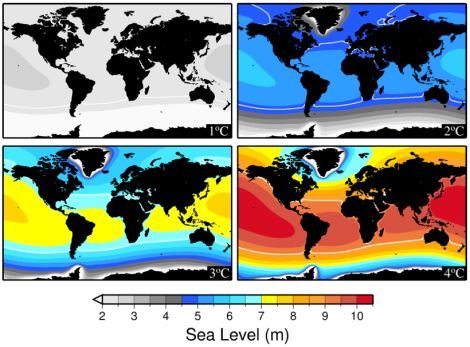
ShutterstockThe future view from your favorite beach.
Sea-level rise is currently measured in millimeters per year, but longer-term effects of global warming are going to force our descendants to measure sea-level rise in meters or yards.
Each Celsius degree of global warming is expected to raise sea levels during the centuries ahead by 2.3 meters, or 2.5 yards, according to a study published Monday in Proceedings of the National Academy of Sciences.
The world is currently trying (and failing) to reach an agreement that would limit global warming to 2 degrees Celsius. Business-as-usual practices could yet raise temperatures by 4 (or even more) degrees Celsius.
Multiply 2.5 yards by 4 and you are left with the specter of tides that lap 10 yards higher in the future than today. That’s 30 feet, the height of a three-story building. For comparison, the seas rose less than a foot last century.
Here is a chart from the new study that illustrates long-term sea-level rise projections under four warming scenarios:
Now, it’s important to note that the new study looks at sea-level rise over the next 2,000 years. The study doesn’t make predictions for how rapidly the seas will rise during that time frame; it just lays out what is possible in the long term. From the study:
On a 2000-year time scale, the sea-level contribution will be largely independent of the exact warming path during the first century. At the same time, 2000 years is a relevant time scale, for example, for society’s cultural heritage.
The difference between this study and others, some of which have foretold less dramatic rises in water levels, is the extent to which it considers ice-sheet melting.
Compared with the amount of water locked up in the world’s glaciers, which are melting rapidly, Earth’s two ice sheets hold incredibly vast reservoirs. The Antarctic ice sheet alone could inundate the world with 60 yards of water if it melted entirely. And then there’s the Greenland ice sheet, which suffered an unprecedented melt last summer.
The ice sheets are not yet melting as dramatically as the glaciers, insulated as they are by their tremendous bulk. In fact, the melting glaciers and the melting ice sheets are contributing roughly equally to today’s rising seas, despite the differences in their overall bulk.
But a hastening decline of the ice sheets is inevitable as accumulating greenhouse gases take their toll.
The authors of the new study, led by the Potsdam Institute for Climate Impact Research, analyzed sea levels and temperatures from millennia past, combining those findings with climate models to get a glimpse of the shifting coastlines of the future. From the study:
[C]limate records suggest a sea-level sensitivity of as much as several meters per degree of warming during previous intervals of Earth history when global temperatures were similar to or warmer than present. While sea-level rise over the last century has been dominated by ocean warming and loss of glaciers, the sensitivity suggested from records of past sea level indicates important contributions from the Greenland and Antarctic ice sheets.
The study’s lead author, Potsdam researcher Anders Levermann, said the results reveal the inevitability of rising water levels as heat accumulates on Earth.
“Continuous sea-level rise is something we cannot avoid unless global temperatures go down again,” he said in a statement. “Thus we can be absolutely certain that we need to adapt. Sea-level rise might be slow on time scales on which we elect governments, but it is inevitable and therefore highly relevant for almost everything we build along our coastlines, for many generations to come.”





